
- MILL HILL
- WILDLIFE REPORTS 2012

Autumn Downland
Butterflies (August):
 |
 |
 |
 |
|
|
|
|
|
Noticeable
summer plants of the upper meadows include Greater
Knapweed, Hardheads (=Lesser Knapweed),
Field
Scabious, Meadow Cranesbill, Alexanders,
Pyramidal
Orchids, Plantains,
Melilots,
Meadow Vetchling, Yarrow,
Eyebrights,
Musk
Thistles, Hounds-tongue*,Perforate
St. John's Wort*, Great Mullein* and
many others. Herb Robert is
found amongst the scrub.
(*notably
on disturbed ground.)
Some
Indicator Plants of Ancient Downland
 |
 |
 |
 |
|
|
|
|
|
Other
indicators on the lower slopes include Dropwort,
Autumn
Ladies Tresses (upper plateau), Hairy
Violet,
all
of which are rarely found on pastures, restored wildlife meadows or agricultural
downland. Other downland plants that are more likely on the biodiverse
down herbland are Wild Thyme,
Carline
Thistle, Stemless Thistle, Squinancywort,
Fairy
Flax, Small Scabious,
Common
Centaury and
Wild
Basil. There are other more widespread
wild plants like the Mouse-eared Hawkweed,
Hawkweeds, Autumnal Hawkbit, Bird's Foot Trefoil, Ground
Ivy, Germander
Speedwell, Field Speedwell, Sweet Violet,
Self-heal
and Yellow Wort.
Wild
Flora and Fauna on Chalk flickr
Adur
Wild Flowers 2009
| OVERVIEW:
A large part (724 acres) of the downs including Mill Hill were presented to the people of Shoreham in 1937. Just over 30 acres still remain as public open land and a Local Nature Reserve. This is divided into about 11 acres of grassland and meadows above the ridge, about 9 acres of scrub, the copse and glades at the northern end, and about half of the prime Chalkhill Blue area of 6.4 acres of herbland remaining. 6 acres has been lost to a Sycamore woodland on the southern slopes. This is low fertility chalkland not suitable for grazing. The top area is effectively a wild meadow and the lower slopes a rabbit warren dominated by prostrate (not the upright form) Horseshoe Vetch, Hippocrepis comosa. |

Horseshoe Vetch |
|||||
| Chalkhill Blues:
Mill
Hill is nationally important because of its population of Chalkhill
Blue Butterflies. Estimates of the numbers
are notoriously inaccurate. In the 1950s
the population was estimated by R. M. Craske
to
be 50,000. This may be an exceptionally good year. I would estimate the
numbers at that time to be nearer 25,000 for Mill Hill only. After the
cattle grazing and thorn incursions the numbers plummeted to the most reliable
estimate in 1960
of 6,000. The new road and Sycamore woodland further denuded the Horseshoe
Vetch, Hippocrepis comosa,
and bare chalk downland to a figure I have estimated at a top figure of
3,000 Chalkhill Blue Butterflies at the turn of the millennium (counted
in 2003). Almost
all these butterflies are now to be found on the six acres of the lower
slopes.
|

 |
|||||
| "Our
family lived at The Mill House, Mill Hill, from around 1933
until about 1967, and every July we saw the
"Butterfly Men" walking past onto the Downs. My father used to tell
us that they were interested in the blue butterflies."
Heather
Clark (née Eager), Ryde, Isle of Wight
|
Nearest
Postcode: BN43 5FH
Grid Ref: TQ 210 074 (upper car park) Geographic Link OS Map Google Earth Map Magic Map of Mill Hill NR Local Nature Reserve Designation Natural England: Local Nature Reserves Multi-Map (Bird's Eye View) |
FEATURE:
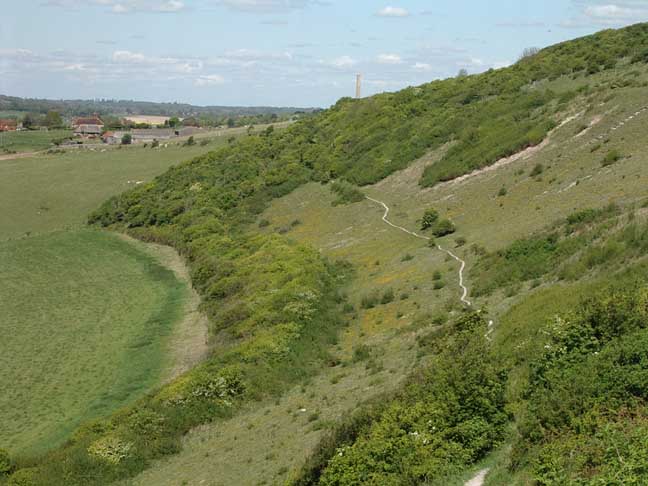
 |
The butterfly lower slopes at Mill Hill are under serious threat by a natural process known as ecological succession where the woody shrubs like Privet, Brambles and Hawthorn invade the herb-rich slopes gradually turning the downs into woodland and eliminating the butterfly larval food plants especially the Horseshoe Vetch, Hippocrepis comosa, on which the Chalkhill Blue Butterflies rely. The remedy is by expert professional removal of the Privet on a regular basis. This job is now being undertaken by volunteers. |

 |
WILDLIFE REPORTS
More
photographs can be found on Mill Hill at facebook
Supplementary
Images Blog
15
October 2012
With
Cumulus
clouds
rushing across the sky, the weather was changeable, the sun shining through
the gaps in the clouds for a few minutes on the lower slopes of Mill
Hill, and I was subsequently battered by hail
blowing horizontally (Force
4) from the west on the upper plateau.
A male Kestrel
hovered over Mill Hill,
silhouetted by the changing
cloud types.
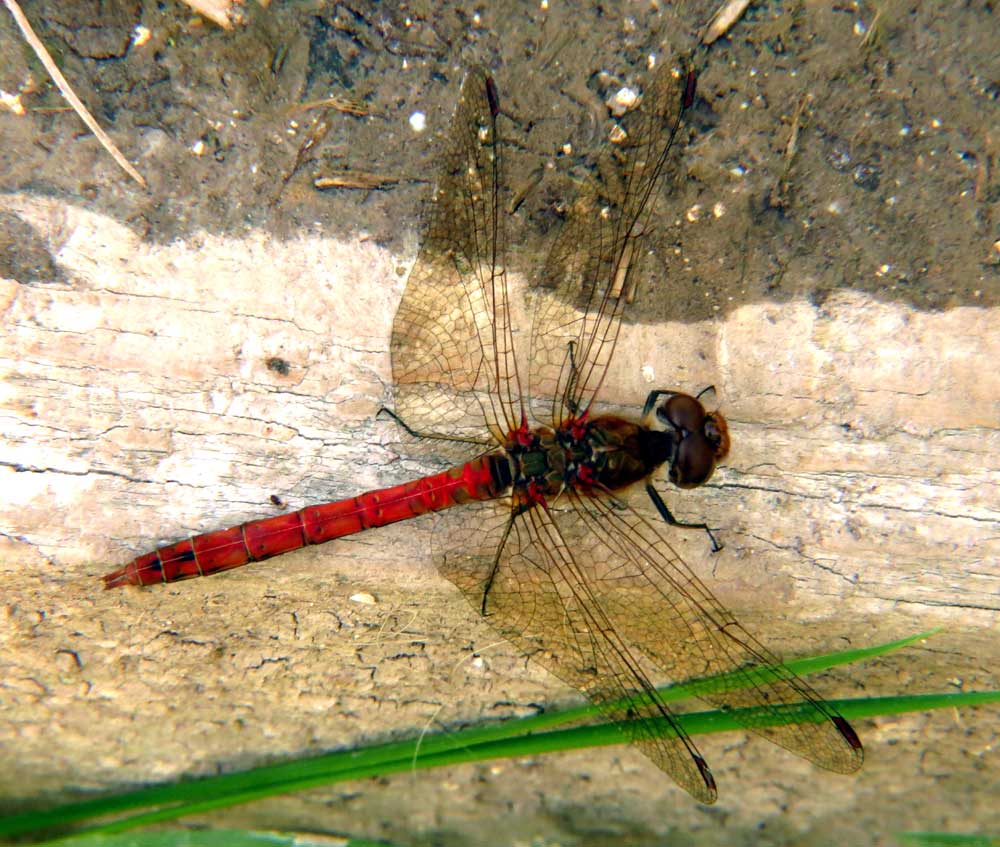 |
 |
|
 |
|
|
|
|
|
Altogether,
there was very little of interest: dragonflies
replaced butterflies
and Common Darters
were frequently seen with 14 counted and one large predatory Southern
Hawker near the copse
at the top of the hill. A Comma Butterfly
rose from some blackberries.
Flowers
were scarce and most had turned to seed. Dogwood
leaves had turned to a dark red and there was the feel of autumn with the
fallen leaves under foot. Two Long-tailed
Tits were noted in the scrub to the north
of the lower slopes.
Shoreham
Weather 2012
10
October 2012
I
had no intention to visit Mill Hill
when I left but a brief spell of sunshine and I made a detour. A
Buzzard
soared over the southern part of Mill Hill Nature
Reserve and drifted over the New Erringham pasture to the east.
A cloud obscured the warm rays of the sun when
I descended to the lower slopes from the southern end. After
the rain of the previous few days, I was not
surprised to see both the algae Nostoc Commune and the White
Dapperling mushroom
on the lower slopes. On the bare patch south of the Reservoir a very large
mushroom rose above the brown soil. I could not see a volva
which ruled out Volvariella gloiocephala.
I
am not sure what species it is? There
were also small clumps of Stropharia
coronilla (probable ID) nearby.
 |
 |
|
 |
|
|
|
|
(without a volva) |
I noted
three Meadow
Brown
Butterflies,
a Red Admiral and
a Comma.
The latter was disturbed when I was collecting blackberries
and I did not see it until it moved after I picked the blackberry
it was on. At least one Common
Darter dragonfly
was seen over the lower slopes.
Adur
Fungi Report
Full
Butterfly Report
4
October 2012
On
the fourth day of the month the rain had stopped and it was worthwhile
taking the camera out. It was relatively cool
(> 15.7 °C)
and a the blustery wind (Force 5 gusting to
Force 6) from the WSW
nearly blew me off the exposed lower slopes of Mill Hill. Conditions were
such that I would not have been surprised if no butterflies
appeared and this appeared to be the case until I saw my first flutter
of a until I saw my first flutter of a Meadow
Brown
Butterfly (probably a Small
Heath) in the Tor Grass, followed
immediately by a Treble-Bar Moth
and shortly afterwards a pristine Comma Butterfly
simultaneously with two Meadow
Brown
Butterflies.
Common
Darters (dragonfly)
frequently
arose from the lower slopes of Mill Hill.
Full
Butterfly Report
 |
 |
 |
|
|
|
|
Wind
swept, slightly muddy, and there were not many flowers.
Carline
Thistle mostly (90%) had silver leaves,
but a few new green growths were budding. After the recent rain I expected
to spot the handful of White Dapperling,
Leucoagaricus
leucothites, mushrooms
growing out from amongst the open herbland. I returned by the shortest
ridge route picking blackberries.
I noted just two flowers of Devil's Bit
Scabious and one Small
Scabious flower. There was also a small
black bee seen visiting Devil's
Bit Scabious, Small
Scabious and Ragwort,
as well as a few Crane-flies.
Traveller's
Joy,
Clematis,
was changing to Old Man's Beard.
Adur
Bees
Adur
Flies
18
September 2012
I
stopped at Mill Hill
to do my weekly butterfly
transect in the sunshine. The results show a considerable decline since
last week: Adonis
Blues
21, Comma
1, Meadow
Brown
55, Small Copper
1, Small Heath
3, Small White
1. I also saw a Treble-bar moth,
Aplocera.
16
September 2012
On
a cool, cloudy breezy day, most of the butterflies
on MIll Hill had disappeared in unfavourable conditions. There was still
frequent Meadow
Brown
Butterflies
and
a few Adonis
Blues
of
both genders, and a Common Carpet
Moth or two.
A
Large White
and Speckled Wood
on the path at the top but that was all. A Southern
Hawker dragonfly
hawked to and fro over the path next to the overgrown top meadow. By
this time dark grey clouds had appeared and one gust nearly blew me over.
 |
 |
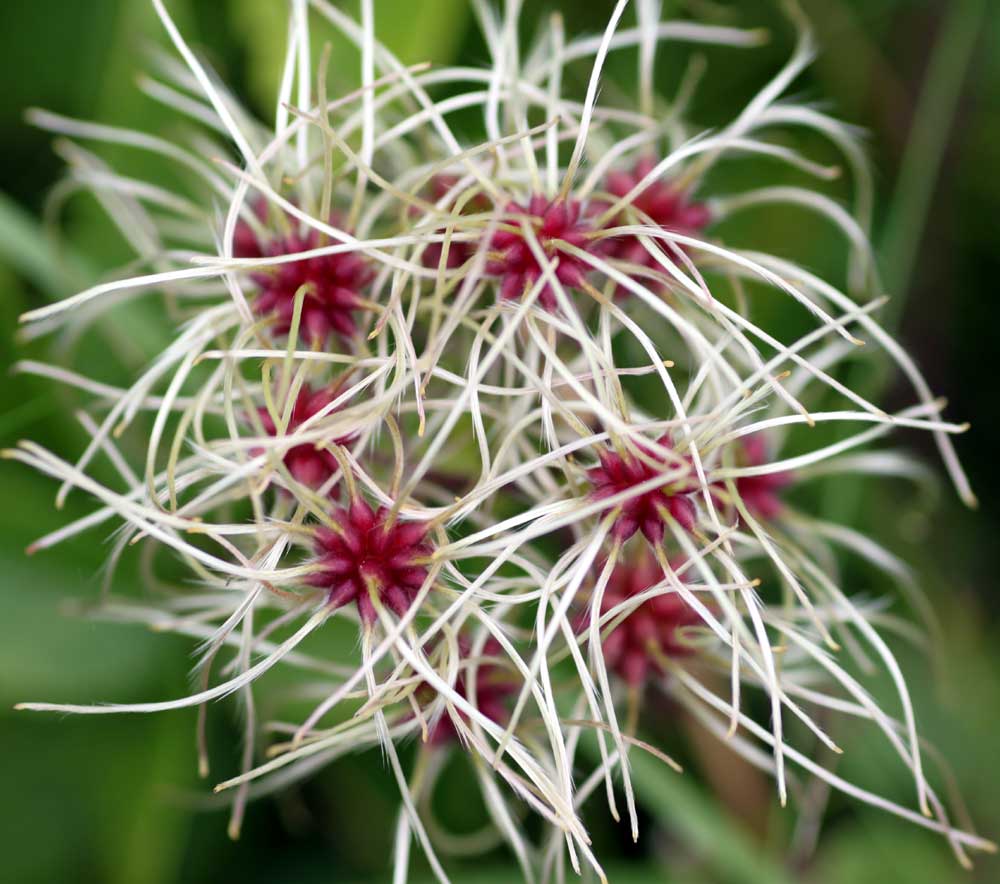 |
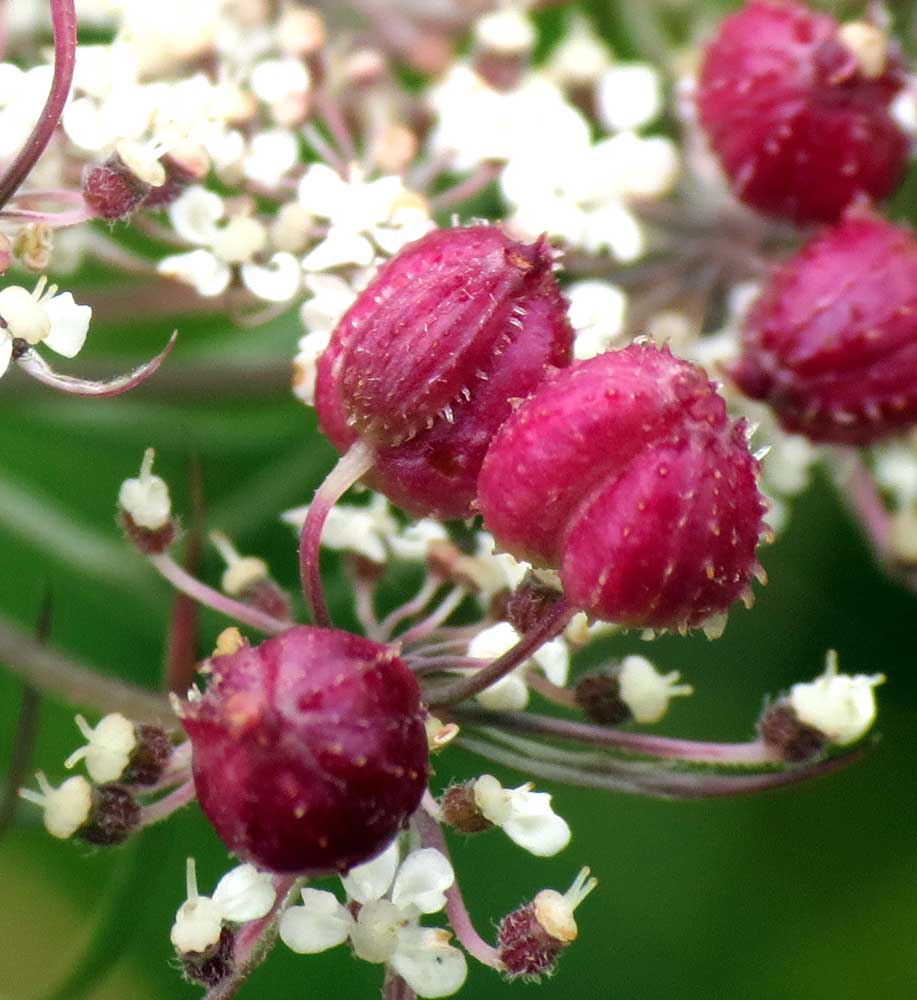 |
|
|
|
|
|
 On
the lower slopes about half of the Carline
Thistle leaves had started to turn from
green to brown to grey but the flowers
still provided nectar sources for bumblebees
and butterflies. However, there was also some new Carline Thistle that
was yet to bud. The Devil's Bit Scabious
was in flower but the ones seen were empty of butterflies. Dwarf
Thistle was still seen in flower. The
host plant for the red entrails of parasitic Dodder
to
attach to was discovered to be Perforate
St. John's Wort. There just one location
discovered at the northern part of the lower slopes. Autumnal
Hawkbit (and other Hawkbits)
were seen but this flower does not seem to be a very attractive nectar
source. Small Scabious
was now recognised from the larger
Field
Scabious and both were in flower. Small
Scabious was found on the lower slopes but
it is best seen near the gate to the Old Erringham pastures. Field
Scabious grows on the deeper soil of the middle
slopes. Amongst the scrub near the gate there was just a single Welted
Thistle remaining in flower. On the top
plateau the short flowering season of Autumn
Gentian had already come to an end. Musk
Thistle was absent from the top of the
ridge area where he has been seen late flowering for years, but there was
still a few plants in flower on the upper slopes. When the cattle trough
has been located the area had deteriorated to Stinging Nettles,
swathes of Greater Willowherb now devoid of seed, with a few still
flowering Creeping Thistles.
In the meadows not all the plants had finished but there was only an occasional
Greater
Knapweed to make a slight show amongst
their deadhead discs.
On
the lower slopes about half of the Carline
Thistle leaves had started to turn from
green to brown to grey but the flowers
still provided nectar sources for bumblebees
and butterflies. However, there was also some new Carline Thistle that
was yet to bud. The Devil's Bit Scabious
was in flower but the ones seen were empty of butterflies. Dwarf
Thistle was still seen in flower. The
host plant for the red entrails of parasitic Dodder
to
attach to was discovered to be Perforate
St. John's Wort. There just one location
discovered at the northern part of the lower slopes. Autumnal
Hawkbit (and other Hawkbits)
were seen but this flower does not seem to be a very attractive nectar
source. Small Scabious
was now recognised from the larger
Field
Scabious and both were in flower. Small
Scabious was found on the lower slopes but
it is best seen near the gate to the Old Erringham pastures. Field
Scabious grows on the deeper soil of the middle
slopes. Amongst the scrub near the gate there was just a single Welted
Thistle remaining in flower. On the top
plateau the short flowering season of Autumn
Gentian had already come to an end. Musk
Thistle was absent from the top of the
ridge area where he has been seen late flowering for years, but there was
still a few plants in flower on the upper slopes. When the cattle trough
has been located the area had deteriorated to Stinging Nettles,
swathes of Greater Willowherb now devoid of seed, with a few still
flowering Creeping Thistles.
In the meadows not all the plants had finished but there was only an occasional
Greater
Knapweed to make a slight show amongst
their deadhead discs.
Scabious
Files
 |
|||
|
|
11
September 2012
On
an overcast breezy day, butterflies
were common on Mill Hill.
Meadow
Brown
Butterflies
were
the most prevalent with an estimated 150+ in the
transect
acre of the lower slopes. Adonis
Blues
were
also common with over a hundred seen. The males
were very tatty and all were damaged to some extent. The females
fared better with 20% of them in fine condition and most of them crawling
in amongst the leaves of Horseshoe Vetch, Hippocrepis
comosa. The tally in the transect acre was 86, with 49
males and
37
females. After I completed the acre and
stopped counting, I then found another hotspot of about 24 more, about
12
males and
12
females all within the transect
acre.
Adonis
Blues
were
not evenly distributed and seemed to be divided into hotspots where the
density was much higher. The males
had to be identified from about ten much fresh and undamaged Common
Blues. The Adonis
Blues
did
not seem to be choosy when visiting nectar sites and they were seen on
Carline
Thistle,
Wild
Basil, Dwarf Thistle, and many of the
common flowers. Small Heath Butterflies
were frequently seen (20+) on the lower slopes with one on the upper meadow.
 |
 |
477.jpg) |
 |
|
|
|
|
|
The
two other species of butterfly were seen on
my downs trip in the middle of the day before it suddenly became cooler
were
occasional Red Admirals
and occasional Large Whites.
Meadow
Browns
were present everywhere on Mill Hill, but they were in the greatest density
over the lower slopes. Moths spotted included
a probable
Vapourer Moth
over the southern part of Mill Hill, and a
few Treble-bar
Moths over
the lower slopes.
Aerial
insect predators were around with a Common
Darter and a Southern
Hawker dragonfly
and a Hornet Robber Fly (first
of the year) over Mill Hill. The hoverfly
Helophilus pendulus was spotted in
the lower car park and this hoverfly has been widespread and more prevalent
than usual this year. The parasitic plant Dodder
Cucusta
epithymum
was discovered on the northern part of the lower slopes.
Adur
Butterfly and Moth List 2012
Adur
Flies
4 September
2012
 In
the morning I made the most of good weather to do my Mill
Hill butterfly transect with the following
result: Adonis
Blues
106, Brown
Argus 1, Common
Blue 1, Meadow
Browns
186, Red Admiral
3, Small Heath 11,
Small
Tortoiseshell 4, Small
White 7, Speckled
Wood 2, Wall
1. The
Small Tortoiseshells
were all on 2 Buddleias.
In
the morning I made the most of good weather to do my Mill
Hill butterfly transect with the following
result: Adonis
Blues
106, Brown
Argus 1, Common
Blue 1, Meadow
Browns
186, Red Admiral
3, Small Heath 11,
Small
Tortoiseshell 4, Small
White 7, Speckled
Wood 2, Wall
1. The
Small Tortoiseshells
were all on 2 Buddleias.
3
September 2012
When
the sun came out in the early afternoon,
the lower slopes of Mill Hill were alive with butterflies.
At one point on my return journey, a spot just above the path it was difficult
to avoid treading on the brown female butterflies
amongst the Horseshoe Vetch leaves.
This was after I had completed my one acre
transect count which was half done in shade
where the butterflies were not so lively. The count of the Adonis
Blues
came
to an unprecedented 205 (132 males 73 females) and this was thought to
be under-recorded by about 45 because of the overcast conditions at first.
Although there were hot spots the
Adonis
Blues seem to be just as prevalent on all
of the five acres of the lower slopes so the total numbers may be in excess
of 800. Many were tatty and damaged but at least 20% of the males were
in fine condition and some looked as good as new. There were two mating
pairs seen and occasional courting pairs. At least a dozen of the females
were crawling amongst the Horseshoe Vetch to lay their eggs so many of
these could have missed the count. The male
Adonis
Blues were very aggressive amongst themselves
but more so chasing off other blue butterflies,
but not harassing them. The nectar plants used by the Adonis
Blues noted were Carline
Thistle, Hardheads, Dwarf Thistle and
Traveller's
Joy (Clematis). They were more interested in mating.
NB:
I noted the considerable difference in colour of the female
Adonis Blues in August
compared to May
this year. I am not absolutely positive that all the brown females are
Adonis
Blues. Some could have been Chalkhill Blues
and one or two might even have been female Common
Blues?
 |
 |
 |
|
amongst the Horseshoe Vetch leaves |
|
|
Because of the numbers of butterflies all appearing at one time were too difficult to count I stopped counting the Meadow Browns, so the part count and part estimates was in excess of 150 in the transect acre. All the other eight butterfly species hardly registered in the final numbers tally. Small Heaths (15+) led the way, with at least half a dozen male Common Blues all being chased by the Adonis Blues, one Speckled Wood over the southernmost steps, a few Large Whites, one Brimstone, one Small White Butterfly, one or two Red Admirals, a Treble-bar Moth and a Shaded Broad-bar Moth. Because of the strength-sapping humid conditions I returned by the path through the lower slopes seeing well over fifty more Adonis Blues. On the top southern part of Mill Hill there were occasional Silver Y Moths, possibly many more, amongst the leaves of Greater Knapweed. The nectar plants used by the Meadow Browns were noted as Wild Basil and Hardheads, but they were more interested in mating as well. The nectar plants used by the Small Heaths were observed as Wild Basil. A Common Blue visited Bird's Foot Trefoil flowers.
28
August 2012
I
did my Mill Hill
transect and was delighted to see a Painted
Lady (first
of the year) and a mating pair of Adonis
Blues.
Other transect results: Adonis
Blue 201, female Brimstone
1, Meadow
Brown
265, Peacock
1, Red Admiral
3, Small Heath
12, Small Tortoiseshell
1, Small White
1, Speckled Wood
1. I then visited Steyning
Downland and joined eight other enthusiasts at the reserve where I
found two Brown Hairstreaks
in reasonable condition.
23
August 2012
Under
another Cumulus
sky, the sun shined only for period of up to ten minutes, but
it was still worth a trip to Mill Hill
by the direct road route through the Dovecote Estate.
Mill
Hill was alive with butterflies
in same places with fifty or a hundred seen all at once on the best parts
of the lower slopes. This was despite a large cloud casting a big shadow
over the hill about midday.
Leader in numbers and presence were the Meadow
Browns,
estimated at more than 350 (maybe 500+) an acre in the best areas on the
lower slopes. They were even more impressive because a third of them were
females are I noted two mating couples. I was difficult to estimate their
numbers but there was at least thousand on the five acres of the lower
slopes and there were many more in the scrub and in moderately high densities
(100+ an acre) on the middle slopes and the top meadows.
 |
 |
 |
|
|
|
on Greater Knapweed |
Rivalling
the Meadow Browns
for presence on the lower slopes were 138 Adonis
Blues
in
the transect acre and many more all over the
lower slopes with a few above the ridge as well. This tally included about
20 brown females. There were only 21 Chalkhill
Blues
(including two females) on the lower slopes and the Common
Blues
were
almost as many, estimated at about a dozen, including four females. Three
Wall
Brown Butterflies on the lower slopes
were more than usual.
It
ws the middle slopes overgrown glades and top meadows that were the stronghold
of the Common Blues
with hundreds seen and many more hiding as cloud blocked out the sun. Walking
through the Hawthorn scrub I encountered Speckled
Woods and Meadow
Browns.
In places the undergrowth had grown so much I did not recognise the paths
that led into the open glades. In a glade with Hemp
Agrimony, there were half a dozen Red
Admirals visiting. As a passing cloud
resulted in a noticeable temperature chill, a Brimstone
Butterfly quickly hid. There
were hundreds of butterflies but only twelve species, plus four species
of micro-moths.
Full
Butterfly Report (First Draft Record) & Species List
On the slopes beneath the upper plateau, Autumn Gentian was common above the very short sward. Devil's Bit Scabious, Carline Thistle and Ploughman's Spikenard began to appear in flower on the lower slopes.
21
August 2012
I
did my Mill Hill butterfly
transect. I parked my car by a Buddleia
and saw two Small Tortoiseshells
and a Red Admiral
on this butterfly magnet. Transect results: Adonis
Blue 121, Chalkhill
Blue 8, Common
Blue 11, Gatekeeper
10, Holly Blue
1, Meadow
Brown
305, Peacock
1, Red Admiral
6, Small Heath
3, Small Tortoiseshell
4, Speckled Wood
4, Wall Brown
14, Small White
1. The Adonis
second brood are booming and this was the largest number of Walls
I have ever seen in one place. 13 species
of butterfly.
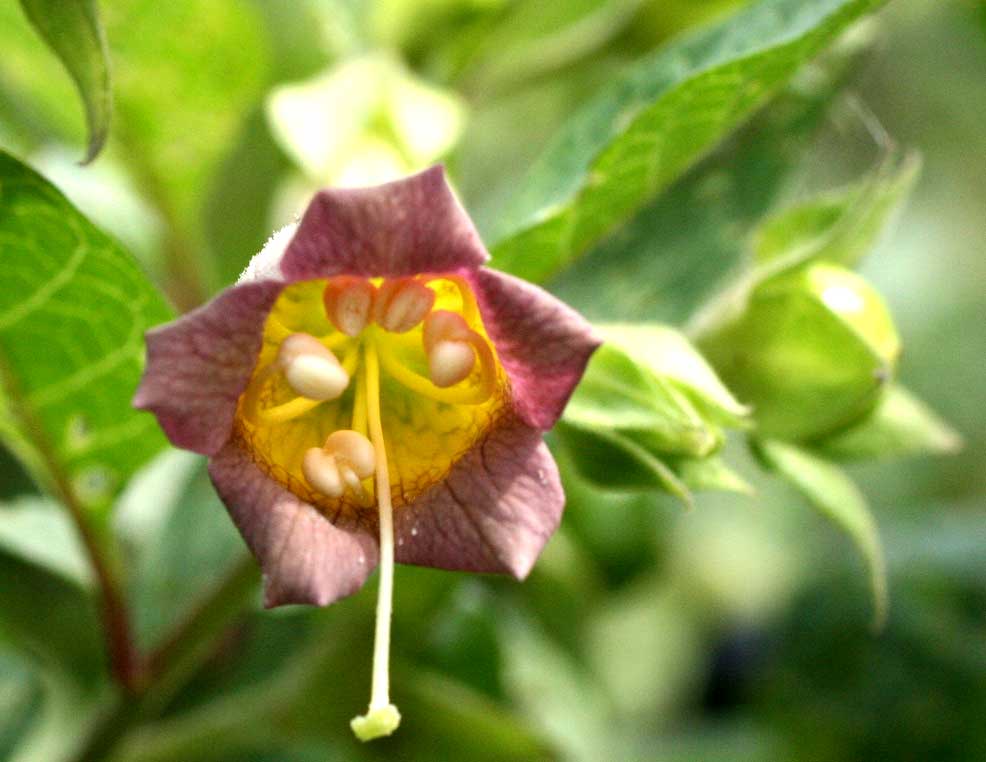 |
20
August 2011
Deadly Nightshade on the lower slopes of Mill Hill. |
17
August 2012
On
a sunny and very humid day the butterflies
were out and about in the early afternoon. They appeared immediately I
descended the steps from the southern end to the lower slopes. A Speckled
Wood showed simultaneously with about
ten butterflies
amongst the hedgerow/scrub bordering the path. These weren't Holly
Blues, but Common
Blues
of
both genders including small version of the attractive blue and brown females.
A Wall Brown landed
on one of the bottom steps at the same time as one of these females (thought
to be a Brown
Argus
at the time).
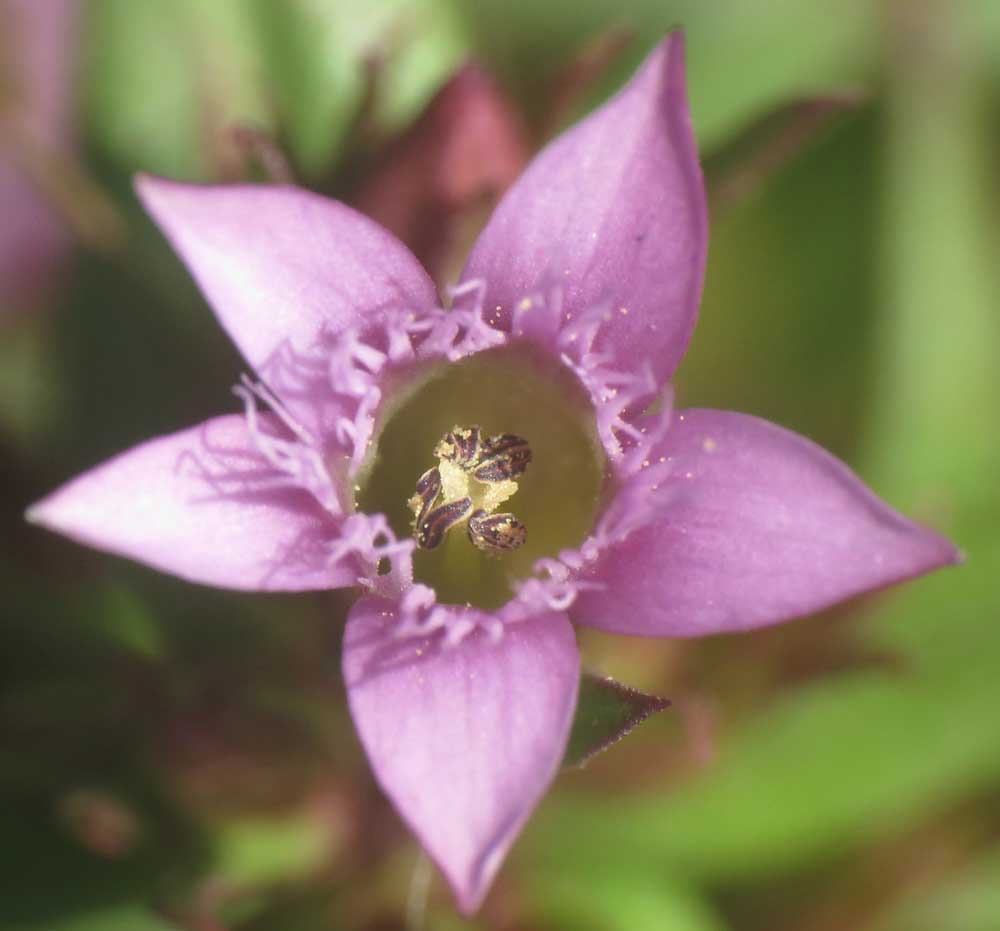 The
open lower slopes were alive with hundreds of butterflies, at an average
of a butterfly per square metre over the southern part of the lower slopes,
usually a less favourable area for numbers on the Shoreham Bank. I spent
under a quarter of an hour on the hill, but I still managed to see over
fifty of each of four species: Meadow
Browns,
Chalkhill
Blues,
Adonis Blues and Common
Blues.
(I
estimated their numbers to be over 100 of each in the transect acre.) At
least half, possibly more, of the Chalkhill
Blues were very tatty.
Brimstone
Butterflies were amorous with their partners
and chased off rival males and a Large
White.
Small
Heath Butterflies chased each other over
the sun bathed slopes. I only completed a quarter
of the transect because it was so humid that
my spectacles misted up. At least one Silver
Y Moth landed in some Privet and the small
pyralid
moths
frequently flitting about the undergrowth were Pyrausta
despicata with at least one Pyrausta
purpuralis. Just when I thought I
was going to have to exclude Gatekeepers
from my list, a female opened its wings in mint condition.
The
open lower slopes were alive with hundreds of butterflies, at an average
of a butterfly per square metre over the southern part of the lower slopes,
usually a less favourable area for numbers on the Shoreham Bank. I spent
under a quarter of an hour on the hill, but I still managed to see over
fifty of each of four species: Meadow
Browns,
Chalkhill
Blues,
Adonis Blues and Common
Blues.
(I
estimated their numbers to be over 100 of each in the transect acre.) At
least half, possibly more, of the Chalkhill
Blues were very tatty.
Brimstone
Butterflies were amorous with their partners
and chased off rival males and a Large
White.
Small
Heath Butterflies chased each other over
the sun bathed slopes. I only completed a quarter
of the transect because it was so humid that
my spectacles misted up. At least one Silver
Y Moth landed in some Privet and the small
pyralid
moths
frequently flitting about the undergrowth were Pyrausta
despicata with at least one Pyrausta
purpuralis. Just when I thought I
was going to have to exclude Gatekeepers
from my list, a female opened its wings in mint condition.
Butterfly
Day List
13
August 2012
A
brief trip to the lower slopes of Mill Hill was curtailed
by rain. It did give me the chance to see
my first second brood male Adonis Blue
of the year immediately as I descended the steps from the southern end.
It was one of 13 seen on an uncompleted (66%)
of the acre transect. A handful more were
noted as walked back along the winding path. The Chalkhill
Blue count was low as well with just 23
males disturbed. Other butterflies
spotted were one Speckled Wood,
one or two Wall Browns
(it could have been the same one), frequent 50+ Meadow
Browns,
frequent 15+ Gatekeepers,
a surprise Small
White, a lonely male Common
Blue and a Small
Heath.
 |
 |
 |
|
|
|
|
A 6-spotted Burnet Moth was first spotted on the now flowering Autumn Gentian. At least two Treble-bar Moths showed and one Common Carpet Moth. The small pyralid moths frequently flitting about the undergrowth were Pyrausta despicata. Carline Thistles were budding and the first flowers appeared.
12
August 2012
I
did my Mill Hill butterfly transect and found the second brood Adonis
Blues have increased dramatically since
Thursday. I also found 3 Small Tortoiseshells
and 3 Walls
which obligingly opened their wings in contrast to those at Chantry Hill
and Steyning. The rest of the transect results: Adonis
Blue 23, Chalkhill
Blue 68, Common
Blue 5, Gatekeeper
7, Holly Blue
1, Meadow
Brown
174, Peacock
1, Red Admiral
1, Small Heath
1, Small White
1, Speckled Wood
1. I saw an Adder
in a usual basking spot and a Roe Deer
dashing across the bottom field.
9
August 2012
I
did my Mill Hill
transect with the following results: Adonis
Blue 4, Brimstone
4, Chalkhill Blue
144, Common Blue
5, Gatekeeper
3, Holly Blue
1, Meadow
Browns
192, Peacock
2, Red Admiral
2, Small Heath
4, Small White
3, Wall
3.
5
August 2012
One
characteristic of chalk downland is the ground hugging prickles of the
small thistle
known variously (as the Stemless Thistle
as the bulb usually appears straight out of the prickly leaves) or the
Dwarf
Thistle. The latter name was more pertinent
in this wet summer
as many of them have visible stems. The flowers
which appear in autumn were very common all over the middle and lower slopes
of Mill Hill. The upper meadows are now too overgrown for it (without
the annual forage harvesting). The leaves
of Mouse-eared Hawkweed
were noted on a part of the middle slopes I do not normally visit.
 |
 |
|
|
|
|
|
Because
of the dreadful weather I missed the peak
emergence of Chalkhill Blues
on Mill Hill this year. (The Chalkhill
Blue Butterflies tend to emerge simultaneously
over two days at the turn of the month.) On
the first suitable (if far from ideal) day
a trip to the lower slopes of Mill Hill discovered only 90 in the transect
acre on a cloudy cool (>18.0
°C ) day.
There were 86 males
seen and four females
including two mating pairs. There were further male Chalkhill
Blues occasionally
noted on the middle and upper part of Mill Hill exceeding ten to bring
the total over a hundred seen in an hour.
NB:
This represents a tremendous fall in the numbers of Chalkhill
Blues since 2003
when thousands shimmered over the Horseshoe
Vetch. The reason for the demise is not known.
In 2003 the acre
count at the peak would be too many to count but in excess of 750 per acre
in the transect acre and 3,000+ simultaneous estimate over the five acres
of the lower slopes at their peak.
2003
Report
On
the southern part of Mill Hill, a Large
White Butterfly and a patrolling large
yellow Brimstone Butterfly
were seen within a couple of minutes. The first butterfly
seen on the lower slopes was a Marbled
White. Subsequently, Meadow
Browns
were
common over the whole of Mill Hill exceeding a hundred in total. Gatekeepers
were frequently seen with
five Small Heath Butterflies
and five Common Carpet Moths
spotted. A few 6-spotted Burnet Moths
flew
with their wings whirring. A Buddleia
bush amongst the deep scrub was an attraction for Red
Admiral and Peacock
Butterflies with at least two of each.
Male Common Blue Butterflies
were frequently seen on the upper meadow (north of the car park) with occasional
Small
Skippers. On the wildlife meadows south-west
of the upper car park I spotted my first
Brown
Argus
of the year (its identity confirmed when it opened its wings).
Adur
Butterflies: First Dates
Full
Butterfly and Moth Report
A Swallow flew over the Ragwort-covered pastures to the east of Mill Hill.
31
July 2012
At
the expected peak period for the Chalkhill
Blue Butterflies I
felt obliged to check out Mill Hill although the conditions were far from
ideal with overcast skies and a very irritating
breeze (Force 5)
and cool (> 18.6 °C).
On Mill Hill the pattern of roosting butterflies
emerged with almost having to step on any butterflies to get them to show.
On the lower slopes one acre transect
I counted 64 Chalkhill Blues
which
comprised 62 active males
and one mating pair spotted in about 30 minutes.
Meadow
Browns
and Gatekeepers were
both frequently seen, most of them disturbed by my presence, with one intact
Small
Heath Butterfly. In contrast to the butterflies,
a few 6-spotted Burnet Moths
flew
with their wings whirring and would not keep still. Other moths
disturbed were two Common Carpet Moths,
a
Treble-bar
Moth or two, and a Shaded
Broad-bar,
Scotopteryx
chenopodiata. Just one Pyrausta
nigrata pyralid
moth made an appearance, but these micro-moths
are easily overlooked.
 |
 |
 |
|
|
|
|
Traversing
the middle slopes of Mill Hill, the scrub hosted occasional Gatekeepers
and a few Meadow
Browns.
I avoided the Copse and upper meadows and plateau and chose a path through
the scrub where a pristine Wall Brown Butterfly
patrolled. This was the first of the second brood I had seen and it visited
a Self-heal flower.
There were five male Chalkhill Blues
seen over the ridge area on the upper part of Mill Hill.
Full
Butterfly Report
As befitting the last day of summer, the budding Autumn Gentian was almost about to burst into flower as was Carline Thistle on the lower slopes of Mill Hill. I recognised Small Scabious as different from Field Scabious.
A caravan
and trailer-sized bare patch has been created on the southern part of Mill
Hill meadow in this month. It will be interesting
to see what grows there? I am not in favour (general principles) of introducing
new plants, but it would be interesting see some Corn
Cockle?
This
area would normally be covered in Greater
Knapweed and Melilot
with Red Bartsia,
Yellow
Rattle and Hardheads
seen in flower next to the patch. Mill Hill
could be improved for wildlife with careful planning?
Some
of the steep slopes on the southern part of Mill Hill have been cleared
of trees and scrub, and Teasels
have colonised.
27
July 2012
It
was cool and humid (18.2 °C,
compared to the last two warm days) and a
visit to Mill Hill saw fresh Chalkhill
Blues emerging.
In the the transect acre 91 of the pale blue males appeared in 20 minutes
on the verdant lower slopes. As it got warmer (20.1
°C) more appeared in flight estimated
at 150 in the acre and I spotted my first brown female of the year. The
vegetation was lusher and greener than normal and included frequent Round-headed
Rampion, the dark blue flowers
appearing above the low sward herbs.
 |
 |
 |
 |
Other
butterflies
on the lower slopes included frequent Meadow
Browns
and Gatekeepers,
a few Large Whites,
at least a pair of Green-veined Whites,
a female Brimstone Butterfly,
a ragged Small Heath,
two Marbled Whites,
two
6-spotted Burnet Moths,
a Treble-bar Moth
and the micro-moth Pyrausta nigrata.
On the southern part of the top of Mill Hill Nature
Reserve, I added a
Small Skipper,
Red
Admiral and a Common
Carpet Moth.
Ten
butterfly species and three macro-moths were noted.
Robin's
Pin Cushion (a gall, created by groups
of larvae of the Gall Wasp,
Diplolepis
rosae) was prominent on at least one of
the Dog Roseplants.
Red Bartsia was spotted for the first
time this year next to the cracked mud path on the lower slopes. This
small herb is a regular feature of the upper meadows. Nearby,
Scabious
was growing and this may have been Small
Scabious.
Two days of sunshine after the heavy rain and already the exposed soil
is cracking. An adult Rabbit
lay dead on the path.
Adur
Butterfly and Moth List 2012
Adur
Pyralids
British
Plant Gall Society
Plant
Galls by Gall Wasps
| 25
July 2012
Dichetophora (Sciomyzidae) fly on the upper part of Mill Hill. It is most likely to be Dichetophora obliterata (female). cf. ID on Diptera.info by Mucha Fero and Jonas Mortelmans Dichetophora
obliterata: an
attractive fly with a rust coloured abdomen and grey thorax. The thighs
are quite distinctive, being orangey-red just above the knee joint but
pale in the upper parts nearer to the body. This widespread species is
known as a snail-killing fly. The larvae are predatory on snails.
|
 23
July 2012
23
July 2012
Under
a blue sky, the sun bathed Mill Hill
in light (>19.3 °C),
and I found myself on an overgrown part of the southern part of Mill
Hill Nature Reserve which was covered in Stinging Nettles and
not normally an area that I visit. A Southern
Hawker (dragonfly)
flew past (first of the year). A path had been worn and by the path a clump
of Marjoram
was beginning to flower. I stopped for a photograph and if I hadn't I would
probably missed three visiting Small Skippers*,
my first of the year. As other places had been reporting an abundance of
Chalkhill
Blues I visited the lower slopes of Mill Hill
again to see if there was a new emergence or a reason for the demise. It
was sunny enough but the tally of butterflies
was like the previous day with 46 fresh flighty male Chalkhill
Blues (in
the 1.2 acre transect) noted, but none appeared
to be new emergences. They were again using Self-heal
as a nectar plant. Meadow
Browns
were
frequently seen but not counted and they numbered at least twenty, occasional
Gatekeepers,
a few Large Whites,
one Small Heath,
two Marbled Whites and
a 6-spotted
Burnet Moth completed
the half an hour tally for the lower slopes. A bright Peacock
Butterfly was seen on the top part as
I returned by the quickest ridge route.
(*These
could be Essex Skippers?)
Butterfly
and Moth List 2012
Adur
Butterflies: First Dates
22
July 2012
At
least the clouds have dispersed and the sun shines and the butterflies
appeared as it warmed up in the early afternoon to a below average 17.8
°C. On the
lower slopes of Mill Hill the fresh male Chalkhill
Blues appeared from the verdant ground
vegetation with 45 counted in the one acre
transect.
This is a week before the peak emergence is due. Some
had darker than normal upper wing borders and their favoured nectar flowers
were Bird's Foot Trefoil
and Self-heal.
The second most prevalent butterfly were the frequent Meadow
Browns
of
the seven species
seen in just over an hour. 14 Meadow
Browns
were
seen on the lower slopes and about another ten on a more hurried trek over
the middle slopes and upper part of Mill Hill.
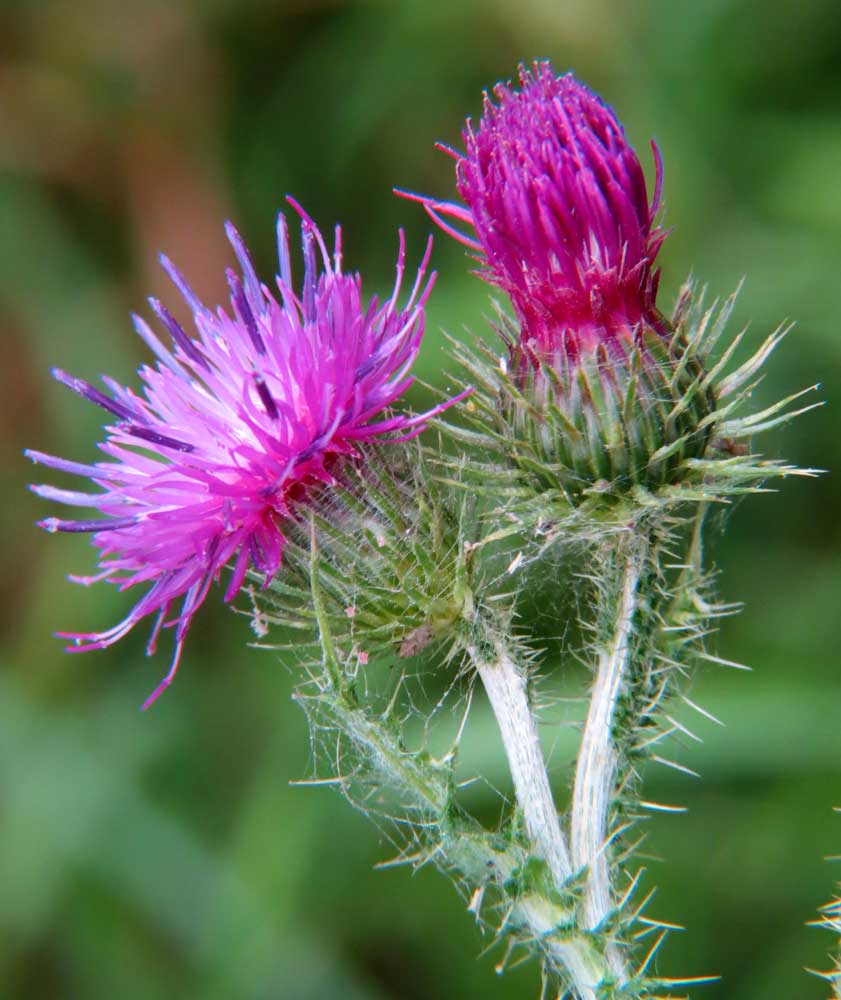 |
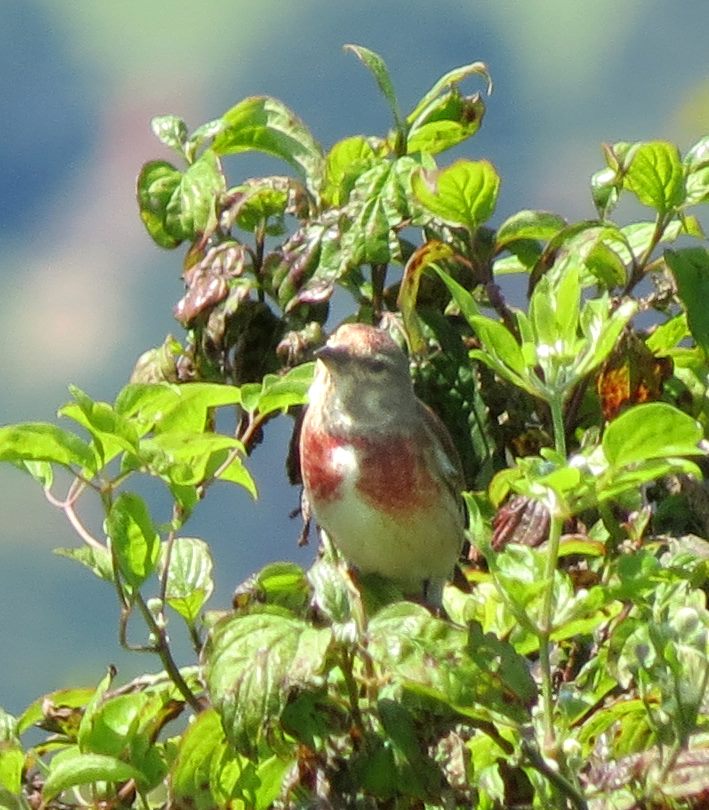 |
 |
 |
|
|
|
|
|
The
lower slopes also hosted a Gatekeeper,
Marbled
White, a Treble-bar
Moth and a Silver
Y Moth. The middle slopes hosted a 6-spotted
Burnet Moth and
under the canopy of the top copse two Speckled
Woods fluttered
around. The top meadows were full of flowering Melilot
and Greater Knapweed
and hosted one more Marbled White as
well as a few more Silver Y Moths. Autumn
Gentian appeared about the plateau turf
but was not yet flowering. A single bunch of Restharrow
was also noted and this plant is not prevalent on Mill Hill and may only
arrived since the cattle have been grazing in the winter. Round-headed
Rampion flowers were frequently seen on
the top of Mill Hill with most of them spotted on the plateau south of
the upper car park.
A
Whitethroat
flew amongst the scrub.. A melody of the Linnet
was heard from the plateau north of the Reservoir as I was about the leave
Mill Hill. There was still time to see a Comma
Butterfly, a pristine Peacock
Butterfly and another Gatekeeper.
Butterfly
& Moth Report
 20
July 2012
20
July 2012
No
sun equals no butterflies, but a visit to
a verdant Mill Hill under a cloudy sky
and I managed to disturb two male Chalkhill
Blues for my first time this year. Two
new Round-headed Rampion flowers
were noted on the lower slopes as well, both of them close to the winding
path. Frequent Stemless Thistle
flowers were seen amongst their prickly leaves. After the blues two Meadow
Brown
Butterflies appeared, possibly because
I almost trod on them. On the southern part of Mill Hill Greater
Knapweed was beginning to flower framed
in the meadows by the yellow swathes of Melilot.
Butterfly
Report
16
July 2012
I
visited Mill Hill.
As soon as I dropped onto the lower slopes I saw my first Chalkhill
Blue of the year. This was followed by
another ten plus a magnificent Peacock,
Meadow
Browns,
Small
Heath, Gatekeepers,
Green-veined
and Large Whites.
15
July 2012
There
was standing water on the southern part of Mill Hill on a cool day (15.1
°C) with small amounts of the algae Nostoc
Commune on the lower slopes. Any butterflies
needed to be disturbed and there were just a handful seen under a under
a cloudy sky on the lower slopes: two Marbled
Whites, a surprise Comma,
one
Small
Heath and two Meadow
Browns.
The best place for all the butterflies was the largest Tor Grass
patch where a pyralid
micro-moth Pyrausta nigrata
was clearly seen. There was also a Gatekeeper
and an unidentified white butterfly
on the wind swept top part of the hill.
An unusually verdant Mill Hill (upper)
|
About twenty Cinnabar Moth caterpillars were seen on just two budding Ragwort plants near the top of the steps at the southern end of Mill Hill. |
 |
13
July 2012
Another
unseasonably cool and overcast day. Despite being not warm enough (>16.2
°C) for butterflies,
I made a brief trek to the lower slopes of Mill Hill. Conditions
were worse than expected, with a Moderate
Breeze Force 5,
gusting to Force 7, blowing from the south-west
straight on to the exposed slopes. And rain was in the air.
I
did manage to disturb my first
Gatekeeper
of
the year as well as a single Meadow
Brown.
A pale Treble-bar Moth
was disturbed as well.
Butterfly
and Moth List 2012
Adur
Butterflies: First Dates
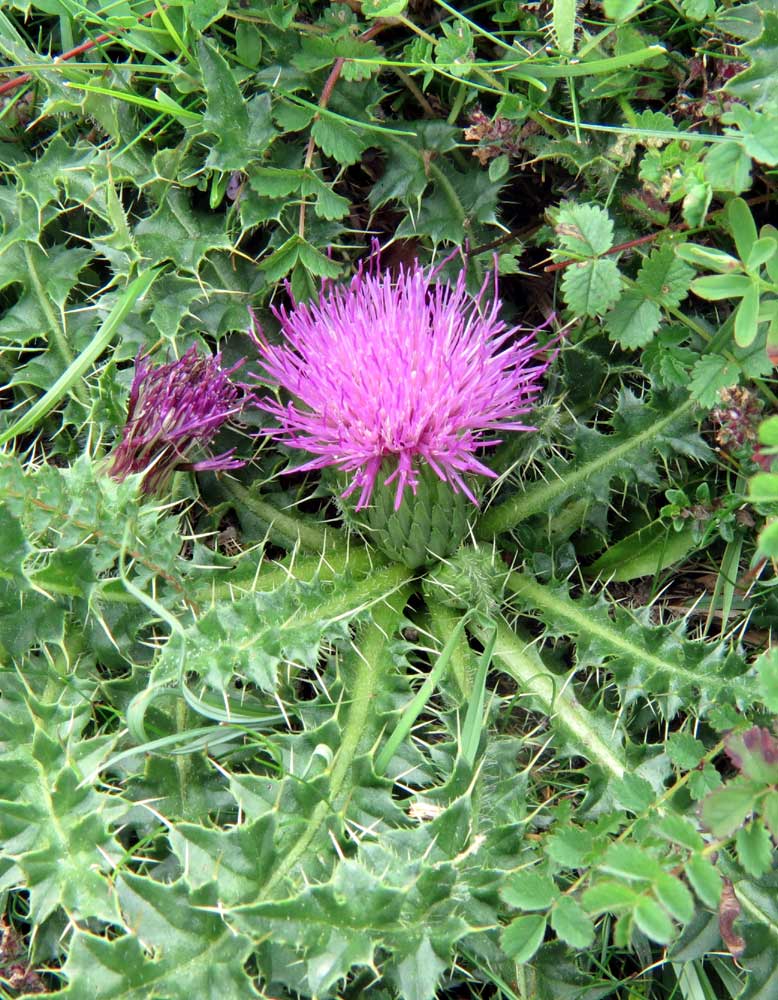 |
 |
 |
 |
|
|
|
|
|
After the wettest June on record continuing into July, the lower slopes were looking lusher than usual. The foliage was greener than the normal parched appearance. The leaves of Horseshoe Vetch and Salad Burnet predominated, but the chalkhill vegetation was varied. The flowers of the following were noted as being abundant on the lower slopes: Eyebright, Squinancywort, St. John's Wort, Autumnal Hawkbit, Bird's Foot Trefoil and Wild Thyme. Diminutive Self-heal flowers were particularly common on the lower slopes this year. And there will be more as some were still budding. Wild Basil, Stemless Thistle, Centaury and Field Scabious were noted in flower for the first time this year on the lower slopes. The green shoots of Carline Thistle was appearing above ground as there were still some of the old grey plants around from last year. Some of the yellow rosettes belonged to one of the Hawkweeds or perhaps, more likely to be Cat's Ear ?
On the southern part of the upper part of Mill Hill, the abundant yellow Melilot was framed by the abundant purple Greater Knapweed. Hogweed was noted in passing as the rain spots got heavier, the large plant swaying in the gale force gusts. Meadow Vetchling was noted on the eastern verge of the country road, next to the pastures of New Erringham.
The wet weather in June and the first half of July resulted in a verdant lower slopes of Mill Hill with even more abundant leaves of Horseshoe Vetch, Hippocrepis comosa, than usual. There was plenty of hiding places for any newly emerged Chalkhill Blues and none were seen on a damp breezy day.
4 July
2012
I
visited Mill Hill in the afternoon on what turned out to be uncomfortable
humid conditions and slippery under foot. I did manage to spot my first
four Marble White Butterflies
of the year as well as eight Small Heath
Butterflies, a few Silver
Y Moths and one faded pyralid
micro-moth Pyrausta pupuralis
on half of the lower slopes transect only.
Great
Mullein was now flowering on the lower
slopes and I spotted the first tiny flower
of Vervain.
Wild
Thyme,
Bird's
Foot Trefoil and Eyebright
were abundant and Hawbkits,
Self-heal
and Perforate St. John's Wort
commonly seen in flower. After the wet weather
I was not surprised to discover two White
Dapperling mushrooms. South of the Reservoir
there was a patch of Meadow Cranesbill
five
metres to the north of the Broomrape.
On the eastern edge of the road I noted my first Field
Scabious and flowering Mugwort.
Adur
Butterfly & Moth List
27
June 2012
On
a humid overcast day, large swathes of Bird's
Foot Trefoil were seen on the pastures
and meadows below, above and on the middle slopes and upper plateau of
MIll Hill. Not surprisingly there were very few butterflies
although eleven Small Heaths
including courting pairs on the lower slopes with a Yellow
Shell Moth disturbed amongst the abundant
flowering Privet,
and four pyralid moths
with Pyrausta nigrata and
Pyrausta
despicata
identified.
 |
 |
 |
 |
 |
|
|
|
|
|
|
Flowers
noted for the first time this year on the lower slopes included Squinancywort
and
the upper slopes Musk Thistle,
and in the middle area White Campion,
and one the edge of the road
Meadow Vetchling.
As the rain curtailed my visit I heard the
prolonged song of the Skylark,
but I could not see this small bird as the
grey clouds rolled in.
More
Flowers
24
June 2012
There
were not many butterflies
on Mill Hill
despite good conditions: two Meadow
Brown, 17 Small
Heaths and a Marbled
White, (my first of the year), were recorded.
18
June 2012
 I
made a quick sojourn to the upper part of Mill Hill north of reservoir
with a brief detour to the middle slopes. In
conditions too cool and breezy to be inimical
for
butterflies
I noted three Small Tortoiseshells
and a Silver Y Moth
over the meadows fringing the copse at the top and a Speckled
Wood under the shade of the trees. Plants
coming into flower included Pyramidal
Orchid, Greater Knapweed and Agrimony.
The Triangle section of the middle slopes
(northern end) was swathed in the yellow of Bird's
Foot Trefoil, although there was also
some Horseshoe Vetch
still flowering. Dogwood
was also flowering. I also noted large bunches of Bladder
Campion* next to the road and occasional
Red
Campion amongst the scrub. (*
ID
to
be checked.) Nipplewort
was seen on the edge of the road.
I
made a quick sojourn to the upper part of Mill Hill north of reservoir
with a brief detour to the middle slopes. In
conditions too cool and breezy to be inimical
for
butterflies
I noted three Small Tortoiseshells
and a Silver Y Moth
over the meadows fringing the copse at the top and a Speckled
Wood under the shade of the trees. Plants
coming into flower included Pyramidal
Orchid, Greater Knapweed and Agrimony.
The Triangle section of the middle slopes
(northern end) was swathed in the yellow of Bird's
Foot Trefoil, although there was also
some Horseshoe Vetch
still flowering. Dogwood
was also flowering. I also noted large bunches of Bladder
Campion* next to the road and occasional
Red
Campion amongst the scrub. (*
ID
to
be checked.) Nipplewort
was seen on the edge of the road.
Full
Butterfly Report
Adur
Campions
17
June 2012
I
did my weekly butterfly transect at Mill Hill.
There were no Adonis
or Common Blues so
I guess the recent gales had finished them off. "The Adonis
have had a bad year compared to last year."
I saw a Holly Blue,
two Small Tortoiseshells,
a Meadow Brown
and 12 Small Heaths.
Small
Heaths have been showing in good numbers everywhere
but Small Tortoiseshells
were
having a bad year nationally. It was good
to see sizeable Mullein Moth caterpillars,
Shargacucullia
verbasci, in large numbers on three
Great
Mullein plants.
14
June 2012
Just
a footprint away, I nearly trod on an Adder
on the lower slopes of Mill Hill, all coiled up basking under the clouds,
before it slithered into the undergrowth before I could get my camera to
focus. It was an adult grey snake with the distinctive black diamond markings
and a chunky good looking specimen. Too cool
(about 16 °C, Force
5) for butterflies
to be active, I nevertheless saw at least a dozen Small
Heaths were lively and I recorded two
Adonis
Blues (one of each gender) and a male
Common
Blue. The damaged and old male Adonis
Blue was roosting amongst some Tor Grass.
The first fluttering was a Yellow Shell
Moth followed by the first of a few Treble
Bar Moths. A few of the small
pyralid
micro-moths were seen, notably Pyrausta
pupuralis and
Pyrausta
despicata
definitely identified.
 |
 |
 |
 |
 |
|
|
|
|
|
|
Parasitic
plants were also appearing, notably on Mill Hill with the first appearance
of the year of a species of Broomrape
(possibly Knapweed Broomrape)
and the first of the prevalent Yellow Rattle
on the southern (top) part of Mill Hill. The diminutive Eyebright
and Wild Thyme
had come into flower on the lower slopes,
where Dog Violets were
still common and I saw my first Yellow
Wort this year. A few small
bees were seen in the flower heads of
the Lesser Hawkbits.
Greater
Knapweed was seen in flower next to the
road by the bridge over the A27
to Mill Hill. (I did not visit the upper part
of Mill Hill.)
Full
Butterfly & Moth Report
 |
With the Horseshoe Vetch, Hippocrepis comosa, almost gone on Mill Hill, the large patches of yellow plants on the downs pastures and Adur Levels were Bird's Foot Trefoil. However, it was such a strange year that there were still some new buds of Horseshoe Vetch. |
I started off by doing my weekly butterfly transect at Mill Hill. The results were disappointing as numbers were very low and the few Adonis Blues were weather beaten following the exceptionally heavy rainfall of the past few days. Count (previous week's numbers in brackets): Adonis Blue male 3 (15), female 5 (3), Small Heath 6 (16).
5
June 2012
In
the morning I had a window of dry, warm weather so I did my weekly butterfly
transect at Mill Hill.
When I finished I was able to do some photography before the rain settled
in for the rest of the day. I noticed some more of the Milkwort
plus the delicate white flowers and pink buds of Dropwort.
Butterfly
count:
Adonis
Blue:
male 15, female 3
Common
Blue:
male 3, female 1
Dingy
Skipper 1
Small
Heath: 16
1
June 2012
A
very early start at 5:30 am
to catch the roosting butterflies
on the lowers slopes of Mill Hill;
there were many roosting butterflies, mainly on clumps of tall grasses.
Afterwards I did my weekly transect:
Adonis
Blue male 92
Adonis
Blue female 22
Common
Blue 8
Small
Heath 29
Small
Copper 1
Columbine, Aquilegia vulgaris, was spotted in flower.
 |
 |
 |
 |
|
Horseshoe Vetch |
|
|
|
Adonis
Blue Butterflies
were particularly common and the acre transect
count came to at least 128 (including five
females and a mating pair). I spotted my first my first of two Burnet
Companion Moths of the year on the lower
slopes (the only area visited).
Small
Heath Butterflies were frequently seen
(25+) amongst the short vegetation landing with their wings closed and
sometimes at an oblique angle to the sun. Two small white butterflies patrolled
the bottom hedge without landing to reveal its identity. I would think
it is probably a Green-veined White.
The Brimstone Butterfly
was positively huge as they sparred, the first of two. A few Treble-bar
Moths were seen landing on the Brambles
and this moth will land on Privet as well. At
the northern end of the lower slopes frequent
male
Common Blues
(12+) mixed with the Adonis Blues and
there were probably some small females
as well.
Just
as I was about to leave I had a fleeting glance of an elusive Green
Hairstreak. I returned via the lower slopes and then noted five Dingy
Skippers at the southern end (area
missed out at first). This area upped the
Adonis
Blues
count including the mating pair. An then I spotted another Green Hairstreak
which was very keen on visiting Horseshoe
Vetch,
Hippocrepis comosa.
Finally, at the top of the steps at the southern end, a Comma
Butterfly flew past.
Full
Butterfly & Moth Report
 23
May 2012
23
May 2012
On
a warm (20 °C)
sticky day, the Horseshoe
Vetch,
Hippocrepis comosa,
was at its peak flowering on the lower slopes of Mill Hill and was comparable
to other years but not to a good year. The new young growths of Privet
were extensive. Adonis Blues
appeared immediately and although the transect acre count was 32 (including
three females) they did not come out until later when I estimated about
sixty. Altogether ten species
were butterfly were spotted on a day when
not all of them were prepared to show in the middle of the day. Small
Heaths were frequently seen, a handful
of Brimstone Butterflies but
only two Dingy Skippers were
noted. There were hundreds of the late-flowering violets,
more than noted in previous years. Dropwort
was
budding.
Full
Butterfly Report
20
May 2012
Again,
too cool (14.2 °C)
for butterflies
and too breezy (Force
4 from the north) to photograph flowers
close-up, overcast without any sun, the rain of the past few days had nevertheless
stopped. Nevertheless, I made an afternoon
trip to Mill Hill to check out the extent
of the Horseshoe Vetch,
Hippocrepis
comosa, which was not so extensive
in previous years and nearly at its peak. Despite the cool conditions I
did note a Holly Blue
and a Red Admiral
at the top of Chanctonbury Drive (SE of Mill Hill). On the lower slopes
of Mill Hill, there were no sign of butterflies at first and eventually
the first of 23+ Adonis Bluesappeared
and this included a fresh female, the first seen this year. Other butterflies
seen on the lower slopes were a few Small
Heath and just the one Dingy
Skipper. The first Lesser
Hawkbits, Leontodon
taraxacoides, of the year, was seen
on the lower slopes. Forget-me-nots
were recorded and I do not recall seeing them before on Mill Hill. There
were still hundred of violets
although they were battered by the recent rain. I thought one had a vague
perfume.
 |
447.jpg) |
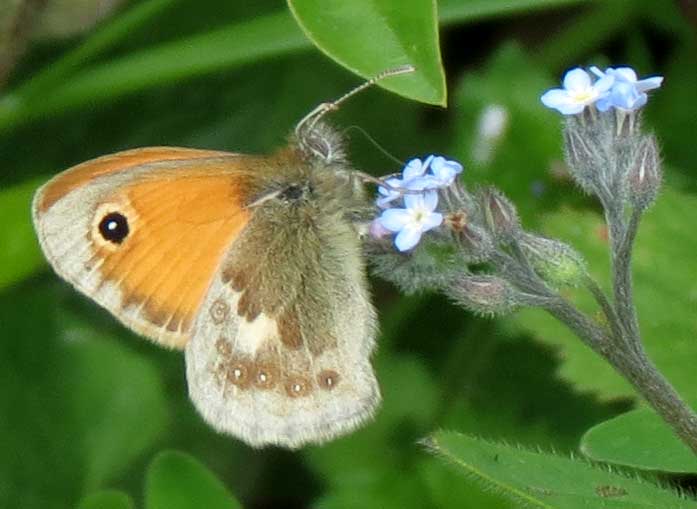 |
 |
|
|
|
|
|
For
the first time this year I travelled to the middle and upper part of Mill
Hill, but there were no butterflies seen. There were patches of Horseshoe
Vetch on the top plateau (south of the upper
car park), but the meadow north of the car park was in a bad way
(like a rough partial cattle pasture).
Hounds-tongue
was beginning to flower and the first Wild
Mignonette was spotted on the upper plateau
of Mill Hill, with White Campion
on the roadside. Elderflower was
budding with the first flowers noted.
13
May 2012
On
the lower slopes of Mill Hill, the Horseshoe
Vetch,
Hippocrepis comosa,
flowers
were now making a show appreciable enough to be seen as I descended the
steps (from the south) where my first Common
Lizard Lacerta
vivipara, of the year was spotted
next to a discarded plastic bag. A new spread of violets
were present in hundreds. They all had a purple spur and rounded sepals.
Because of their different flowering date and a even violet (with a few
white specimens) colour, I have tentatively identified these as Hairy
Violets, Viola hirta.
Adur
Lizards
Adur
Violets
 |
 |
 |
 |
|
|
|
|
|
At
last the sun came out (13.0 °C at
1:00 pm, with
a Moderate Breeze Force 4)
and with the warmth encouraged the butterflies
and for for the first time this year they were common (100+) on the lower
slopes of Mill Hill.
But they were slow to appear at first, frequent Dingy
Skippers and a few bright blue male Adonis
Blues were both very lively. A pristine
Peacock
Butterfly basked on a Cotoneaster.
After twenty minutes the numbers increased and there were at least twenty
Adonis
Blues,
Dingy
Skippers everywhere (60+), a few Green-veined
Whites,
Brimstone
Butterflies of both genders (one female
sparred with a Green-veined White),
the first male of a few Common Blues
of the year, my first of four Small Coppers,
occasional
Small
Heaths, at least two Grizzled
Skippers, a fleeting glimpse of a Wall
Brown and a single Comma
Butterfly. Both the Common
Blues and Small
Coppers visited Milkworts
(not
the more plentiful Horseshoe Vetch).
One of the Small Heaths
was so worn its orange looked the colour of a Gatekeeper.
Moths
included a Treble-bar and
the micro-moth Agapeta
hamana.
Full
Butterfly Report
Adur
Butterflies: First Dates
Adur
Skippers
Adur
Moths
A Green Hairstreak Butterfly visited a Horseshoe Vetch flower on the lower slopes of Mill Hill, as well as taking an excellent photograph of the micro-moth Pancalia leuwenhoekella.
7
May 2012
A
quick late afternoon dash to Mill Hill
provided the first butterflies of any kind this Bank Holiday! In an hour
or so we saw about 20 Dingy Skippers,
5-10 Grizzled Skippers,
1 Peacock,
3 Green Hairstreaks
and two lovely fresh Wall Brown Butterflies
(first of the year). Small
Copper and Small
Heath also seen (but not by us).
30
April 2012
A
bright turquoise-blue sky showed in the north and east on a breezy unpromising
day, but the sun and some of butterflies
came out in the afternoon. I checked out the
lower slopes of Mill Hill where my first of 14 Dingy
Skippers flitted between the thousands
of Horseshoe Vetch,
Hippocrepis
comosa, flowers.
I also spotted by first Small Heath Butterfly
of 2012. The
small day-flying pyralid
moth
Pyrausta nigrata flitted
occasionally between the Horseshoe Vetch
which all hosted the small black pollen beetles
Meligethes. At the top of the hill
around the Alexanders on the east side of
the road just north of the hedge by the house, a male Orange-tip
Butterfly fluttered around without pausing.
 |
|
|
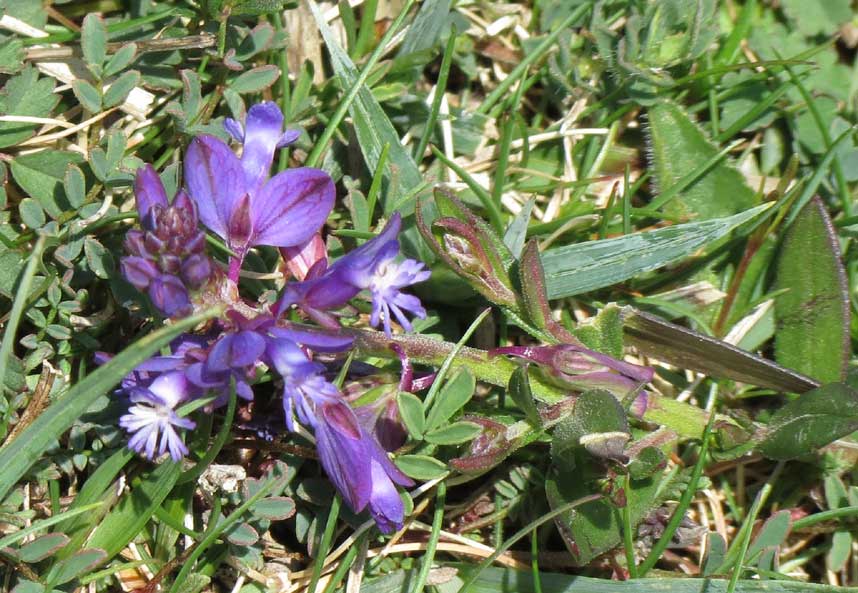 |
|
with Violet leaves |
|
|
|
Flowers
noted on the lowers slopes included Horseshoe
Vetch, Cowslips, Common Daisies, Milkwort,
Germander Speedwell, Bluebells and
Dog
Violets.
(I
was not happy with the focusing and macro of my new Canon
SX40 and now wished I had purchased another camera.)
Full
Butterfly Report
Adur
Skippers
I did my weekly transect at Mill Hill as it was a blue sky day. There were several Green Hairstreaks at the north end of the lower slopes, plus many Dingy Skippers and some Grizzled Skippers. I spotted the brown female Adder at the southern end.
23
April 2012
I
left to do my weekly transect at Mill Hill
as it was a sunny day (it started raining for all of the afternoon around
midday).
There was a wind at the start and I was surprised to find a Grizzled
Skipper at the top of the hill. Beside
the path near the bottom of the hill I found a black Adder.
At the bottom there was another Grizzled Skipper,
a Green-veined White,
a Peacock,
a Small Heath,
Speckled
Wood and many Dingy
Skippers, fighting and nectaring. Just
below the car park I found a Small Copper,
my first of the year. I tried my new camera, a Panasonic
Lumix FZ45 with
close-up
lens, on the Dingy
Skippers and am very satisfied with the results.
I am getting depth of field, clarity of detail and colour vibrancy that
I cannot achieve with my other cameras.
16
April 2012
On
a Cumulus
day too cool for butterflies,
a visit to Mill Hill was
only entertained because the forecast for later in the week was worse.
On
the lower slopes the first flowers of
Horseshoe
Vetch,
Hippocrepis comosa,
appeared with another prostrate downland herb Milkwort.
The tiny black pollen beetles
Meligethes
scrambled over the flowers on
the bank, especially on Horseshoe Vetch, Dandelions
and on a few of the
violets.
Salad
Burnet was just beginning to flower and
their leaves were commonly seen lying prostrate on the bank. Dog
Violets predominated with thousands still
present. The thousands of Sweet Violets had
all faded, which leaves the identity of some of the fresh violets
near the bottom of the slope as a bit of a puzzle. I have tentatively identified
it as a Hairy Violet.
Occasionally,
a skipper (butterfly)
rose
from the ground and fluttered rapidly to a new resting place. The only
one positively identified was a fresh
Grizzled
Skipper. A small bee,
one of the Nomada
species visited a Dandelion.
A few Buff-tailed Bumblebees,
Bombus
terrestris, were noticeable in the absence
of the butterflies.
Adur
Violets
Adur
Butterfly List 2012
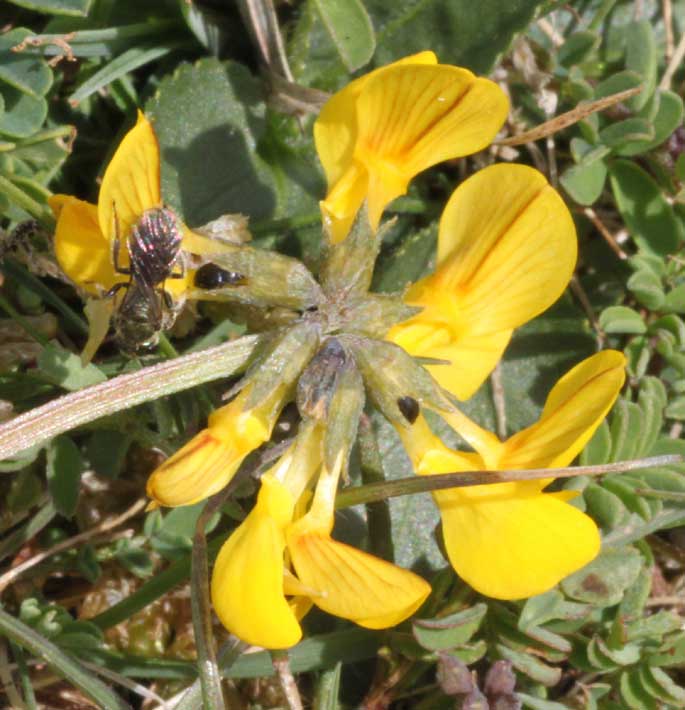 |
 |
 |
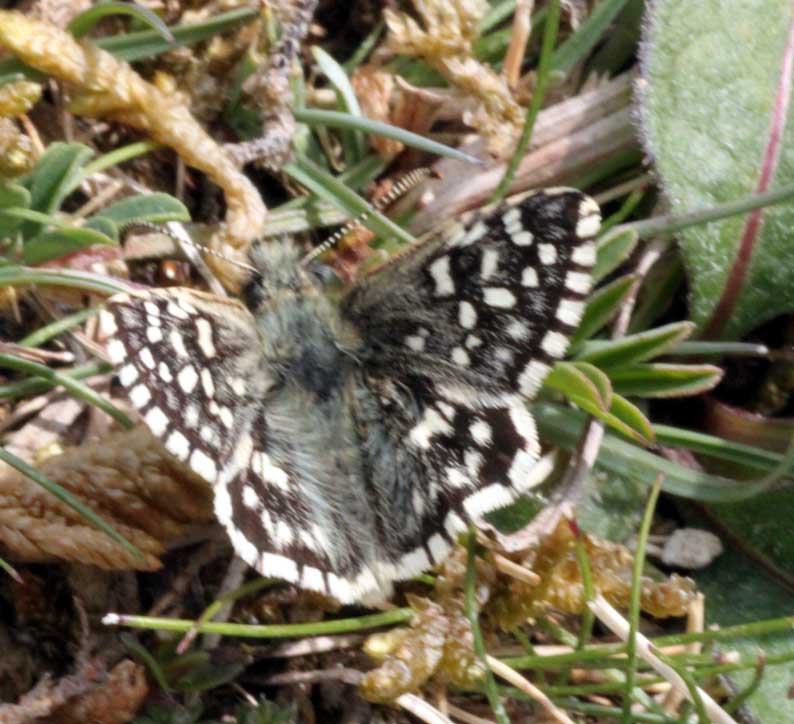 |
|
|
|
|
|
Blackthorn
was flowering near its peak on the top part of Mill Hill and in the scrub.
The first Hawthorn flowers
were noted on Mill Hill and the first Blackthorn
leaves.
The
familiar Kestrel
hovered over the middle slopes.
10
April 2012
On
a sunny day with a cold wind, the male
Adders
performed their dominance
dance a black snake and a normal patterned one intertwining and raising
their heads and front part of their bodies above the flora on the lower
slopes of Mill
Hill down by the scrub at the bottom (west
side). The black Adder
discovered a female underneath the Brambles. Grizzled
Skippers and Small
Heath Butterflies were seen.
|
|
6 April
2012
Dingy
Skippers, a Small
Heath and a Green
Hairstreak Butterfly were all seen for
the first time this year on the lower
slopes of Mill Hill,
with Grizzled Skippers,
a Speckled Wood,
a Green-veined White
and a Peacock Butterfly.
Four
Adders and
a green Common Lizard,
Lacerta
vivipara,
completed a very satisfying afternoon.
3 April
2012
An
unprecedented 26 Grizzled Skippers were
seen on Mill Hill
and only one of them was a female. A handful of Peacocks
and single Comma
and Small White
were the only other butterflies
seen.
1
April 2012
I
visited Mill Hill
again to conduct a butterfly transect. Unfortunately due to the cold wind
I only recorded three butterflies-
a Speckled Wood,
a
Peacock
and a Grizzled Skipper.
However, the dearth of butterflies was compensated for by the excellent
Adder
sightings, all along the bottom of the hill by the bushes. First I saw
a black Adder,
then two grey ones, which slithered along the bush line in their hunt for
food. One moved fast at about about 15 metres per minute and I was able
to keep getting ahead of it to take photos as it approached. However, it
was too fast to get the shots I was after.
30
March 2012
Finally
I gave in to temptation and went to Mill Hill
where I saw five Grizzled Skippers
in various places. One in particular was immaculate and quite beautiful,
so presumably newly emerged. In addition to all the pyralids
on the wing I noticed several tiny, but delightful Violet
Cosmet
Moths, Pancalia
leuwenhoekella,
(approx. 3-4 mm long).
29
March 2012
Encouraged
by the reports of others, I visited Mill Hill and quickly spotted my first
Grizzled
Skipper of the year flying around
on the northern part of the lower slopes.
It
might not have been so easy to spot to newcomers as there were scores of
smaller day-flying pyralid
moths,
mostly Pyrausta pupuralis
and
Pyrausta
despicata but also Pyrausta
nigrata. There were at least a couple
of restless Brimstone Butterflies
and a few more Peacock Butterflies
on the lower slopes of Mill Hill in the middle of the day sunshine. Dog
Violets were in flower
now equalled or exceeded the thousands of Sweet
Violets on the lower slopes of Mill Hill.
Adur
Butterfly List 2012
Adur
Violets
27
March 2012
I
recorded ten different butterfly species
in a day, which I cannot recall ever doing before during the month of March.
In just a couple of hours at Mill Hill (Shoreham)
I counted four Grizzled Skipper (first
of the year), one Orange Tip
(first of the year), one Speckled Wood,
one Holly Blue (first
of the year), one Brimstone,
one Small White,
14 Peacock,
one Red Admiral,
two Small Tortoiseshell
and two Comma.
The day-flying moths Pyrausta pupuralis
and
Pyrausta
despicata were both present in good
numbers, along with the odd Pyrausta
nigrata.
I
was surprised to find a freshly emerged Grizzled
Skipper on Mill
Hill. There were also half a dozen Peacocks
and a Small Tortoiseshell.
Reptiles were also out enjoying the sunshine, one black Adder,
two Common Lizards
and a Slow Worm.
26
March 2012
 |
 |
|
|
|
|
|
|
|
Amongst
the thousand of Sweet Violets
on the lower slopes of Mill Hill, the first Dog
Violets were in flower.
There were at least two Brimstone Butterflies
and at least four Peacock Butterflies,
with at least one more of each over the scrub near the gate to Old Erringham.
Small pyralid moths
were frequently seen flitting amongst the violets
on the lower slopes of Mill Hill, with Pyrausta
nigrata, Pyrausta pupuralis and
Pyrausta
despicata seen very clearly and all
three species definitely identified. This was the earliest and the first
time in March
I seen any of these three species. The micro-moth Violet
Cosmet, Pancalia
leuwenhoekella, was spotted on a Sweet
Violet flower. A
Common
Bee-Fly,
Bombylius
major, (first of the year) was spotted over the path amongst the
Hawthorn scrub on Mill Hill. On the lower slopes, the yellow flowers were
small Dandelions,
and a Red-tailed Bumblebee visited
the Sweet Violets.
Adur
Butterfly List 2012
Adur
Butterfly Flight Times
Adur
Butterflies: First Dates
The
conservation workers have been making inroads on clearing some of the extensive
scrub/woodland on the southern part of Mill Hill.
| 20
March 2012
There was now only one Kestrel hovering above Mill Hill on an overcast day. |
19
March 2012
A
Red
Admiral Butterfly flew over the top of
Chanctonbury Drive (SE of Mill Hill), only my second species of butterfly
seen this year. Long-tailed Tits
flew to and from between the hedges and scrub and the Lesser
Celandines were in the open gardens that
adjoined the grass bank. Two Kestrels soared
high over Mill Hill. On the lower slopes many of the thousands of
Sweet
Violets were looking battered by the recent
rain.
Adur
Butterfly List 2012
Report
on the Mill
Hill Blog
12
March 2012
Under
a blue sky and weak sunshine (14.6
°C) the Sweet
Violets were flowering
on Mill Hill, where I saw two Peacock Butterflies
(my first two butterflies
of the year), one flying across the road at the top of the hill and another
one fluttering over the lower slopes. There was frequent small bird calls
and activity from the Hawthorn bushes and I caught a glimpse of the small
birds but not enough to identify most of them except for the Robin
Redbreast.
There was extensive moss growing at the southern end of the lower
slopes which had been noted early in previous years. The conservation workers
had cleared some of the scrub. I only visited the lower slopes and did
not see any cattle
and only a few dried cow pats on the lower slopes.
Adur
Violets
Adur
Butterfly List 2012
Adur
Butterfly Flight Times
Adur
Butterflies: First Dates
 |
The
photograph on the left is the gall
made by the small gall
wasp Diplolepis
rosae known as Robin's
Pin Cushion. It is found on the Dog
Rose.
The
final instar stage is reached by late October.
The larva ceases feeding. It now passes into the prepupal stage, in which
form it over winters inside the gall known as the bedeguar.
In the following February
or March the
prepupa undergoes a final moult and becomes a pupa.
|
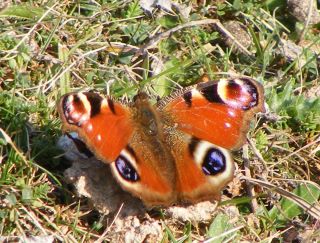
Peacock Butterfly |
10
March 2012
I
visited Mill Hill
to check out the butterfly
transect territory I will be visiting weekly from the beginning of April.
I was hoping the Adders
would be showing and was rewarded with four basking snakes. I had seen
two and was returning by the path and spotted a black one. While photographing
this I noticed a grey one slithering away nearby.
Mill
Hill Wildlife Reports 2011 (Link)
Identification
of Grasses (Link)
Mill
Hill Grasses
17
SPECIES OF BUTTERFLIES DEPENDENT ON MILL HILL
FOR BREEDING:
(Estimated
numbers for Mill Hill Nature Reserve only
are in brackets)
| Chalkhill
Blue (3000 +)
Adonis Blue (50 -100) Dingy Skipper (75) |
Small
Heath (250)
Wall Brown (12) Meadow Brown (300) |
Marbled White (50)
Gatekeeper (200) Speckled Wood (>50) Green-veined White (2+) |
Common
Blue (>4000+)
Small Blue (5) Brimstone (8) |
Small
Skipper (>50)
Large Skipper (10+) Grizzled Skipper (20) Brown Argus (>30) Green Hairstreak ( a few) |
The other species may breed on Mill Hill, but there main breeding area will be adjoining fields or slightly further away. e.g. Small Blue (included above), Small Copper, Small Tortoiseshell, Green-veined White, Peacock, Ringlet, Small White, Large White, Comma, Holly Blue, Orange Tip. (=10)
The following are immigrants &/or hibernators: Red Admiral, Painted Lady, Clouded Yellow.
The following have not been positively identified (because of ID difficulties): Essex Skipper. This species is now included for a local field on the Adur Levels within 500 metres of Mill Hill.
(=30)
The
following was confirmed only in 2009:
Green
Hairstreak.
(=31)
The next one is no longer
found on Mill Hill but were there in the recent (reduced drastically to
almost extinct by 1948 last record in 1968) past: Dark
Green Fritillary (Records of this butterfly
in 1857, 1938, and 1945 when it was common.)
The next one is no longer
found on Mill Hill but were there in the distant (1947) past: Grayling.
The next one has been recorded
near Mill Hill in the middle distance past: White-letter
Hairstreak
(=34)
The
Silver-spotted
Skipper does not appear to ever have occurred
on Mill Hill
The
Silver-studded
Blue has never been recorded from Mill Hill
The Short-tailed Blue was recorded as a single immigrant in 1956.
17
August 2009
A
possible (unconfirmed) Brown Hairstreak Butterfly
was
spotted. A confirmed one was spotted nearby.
There
is also the possibility of one of the Fritillary
butterflies.
Aerial
Map
Lower
Adur Levels (MultiMap) including Lancing Clump and Mill Hill
Horseshoe
Vetch,
Hippocrepis comosa
First
Draft of the Article for the Shoreham Society Newsletter